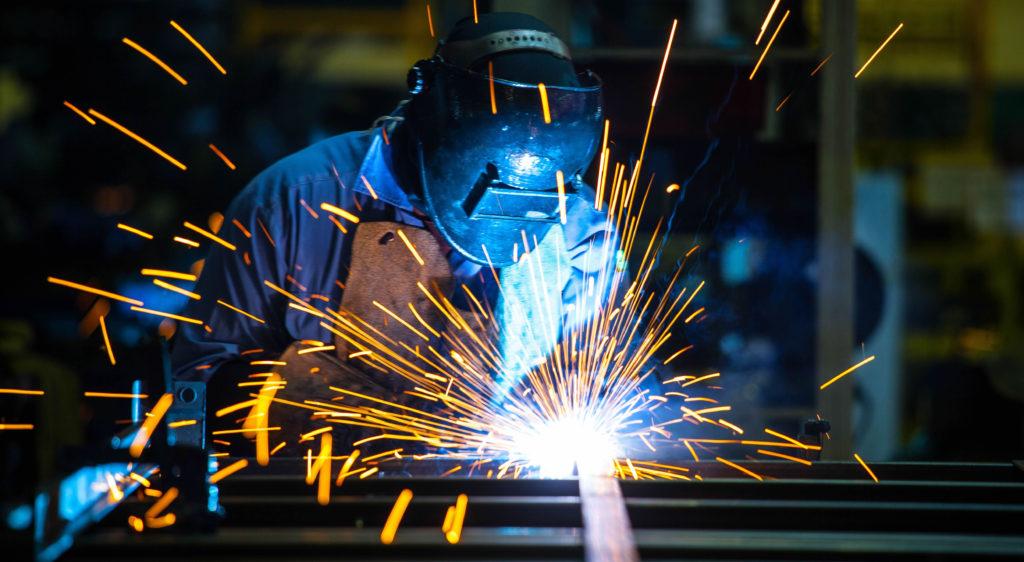Welding is a fabrication process used to join materials, typically metals or thermoplastics, by causing coalescence. This is done by heating the workpieces to suitable temperature with or without applying pressure, with or without the use of filler material. A variety of welding equipment is used depending on the type of welding process employed. The main types of welding equipment are described below in detail along with examples under relevant subheadings.
Oxy-Fuel Gas Welding Equipment
One of the most commonly used welding processes is oxy-fuel welding, also known as oxyacetylene welding. In this process, fuel gas (typically acetylene) and oxygen are supplied to the welding torch through separate hoses connected to high pressure cylinders. The torch has provisions to control and mix fuel gas and oxygen in the correct ratio to produce a welding flame. Depending on the opening of the torch nozzle and the adjustment of gas valves, the flame produced can reach temperatures between 3000-3800°C, which is high enough to melt steel and other weldable metals.
Some key components of oxy-fuel gas welding equipment include fuel gas and oxygen cylinders, regulators to control gas pressure, hoses to carry gases to the torch, the welding torch with mixing head and nozzle, and spark lighters to ignite the torch flame. Safety gear like gloves, goggles, and flame retardant clothing is also required when using this equipment. Oxy-fuel welding finds applications in pipe welding, sheet metal fabrication, and other industrial welding needs.
Electric Arc Welding Equipment
Electric arc welding equipment uses electricity to generate very high temperatures needed for welding. Under this category, the most common processes are shielded metal arc welding (SMAW), gas metal arc welding (GMAW), gas tungsten arc welding (GTAW), flux-cored arc welding (FCAW), and submerged arc welding (SAW).
For SMAW, the essential equipment includes a welding power source, electrode holder, consumable bare electrodes of varying sizes, and protective equipment. GMAW and FCAW use power sources along with a constant voltage welding gun or torch with a consumable wire electrode delivered through the gun. GTAW requires a power source, torch with a non-consumable tungsten electrode, and gas supply for the weld area protection. While SAW uses a power source and continuous wire electrode supply along with granular fusible flux to protect the weld.
Cutting Equipment
Welding also involves cutting of ferrous and non-ferrous metals using both gas and electric arc cutting processes. Oxy-fuel gas cutting machines are used to cut metals up to 25mm thickness using a cutting torch with oxygen and propane or acetylene as cutting gases. Plasma cutting machines use compressed air and electricity to constrict a stream of ionized gas to slice through even thick metal plates. Carbon arc cutting relies on an electric current passed through a carbon electrode to generate very high temperature to cut thin sheet metal. Cutting torches, hoses, and regulators are common to both gas cutting setups.
Automation Equipment
With rising demand for precision and quality in welding, automated and robotic welding systems have become prevalent in manufacturing. Motorized welding positioners hold the workpieces and welds are deposited using automatic or robotic weld guns. Computer numerical controlled (CNC) positioners offer multi-axis control to maneuver the weld torch and weld joint seam tracking devices are also available. Robotic welding cells consist of an industrial robot with an end-of-arm tooling (EAO) that can be a welding torch or electrode holder. The robot is precisely programmed to duplicate weld joints and sequences. Integrated weld inspection systems help implement quality control. Moreover, mechanized weld jigs ensure consistent joint alignment for automated welding.
Ancillary Equipment
Several other auxiliary equipment play a supporting role to the main welding tools. Wire feeders supply the electrode wire at a controlled rate in GMAW and FCAW. Coolant systems like air conditioning units and local fume extractors help manage heat and fumes during welding. Personal protection tools like leather gloves, helmets, filter lenses, and aprons protect welders from extreme heat, arc rays, spatter, and sparks. Weld curtains made of plastic sheets or fire-retardant materials shield nearby areas from radiated heat and light during welding jobs. Various types of clamps, jigs and fixtures held the workpieces together during fabrication and assembly welding applications.
Get more insights on this topic: https://www.newsanalyticspro.com/welding-equipment-essential-tools-for-any-welding-job/
Explore more trending article on this topic: https://captionssky.com/bottled-water-industry-in-united-states-an-ever-growing-segment/
